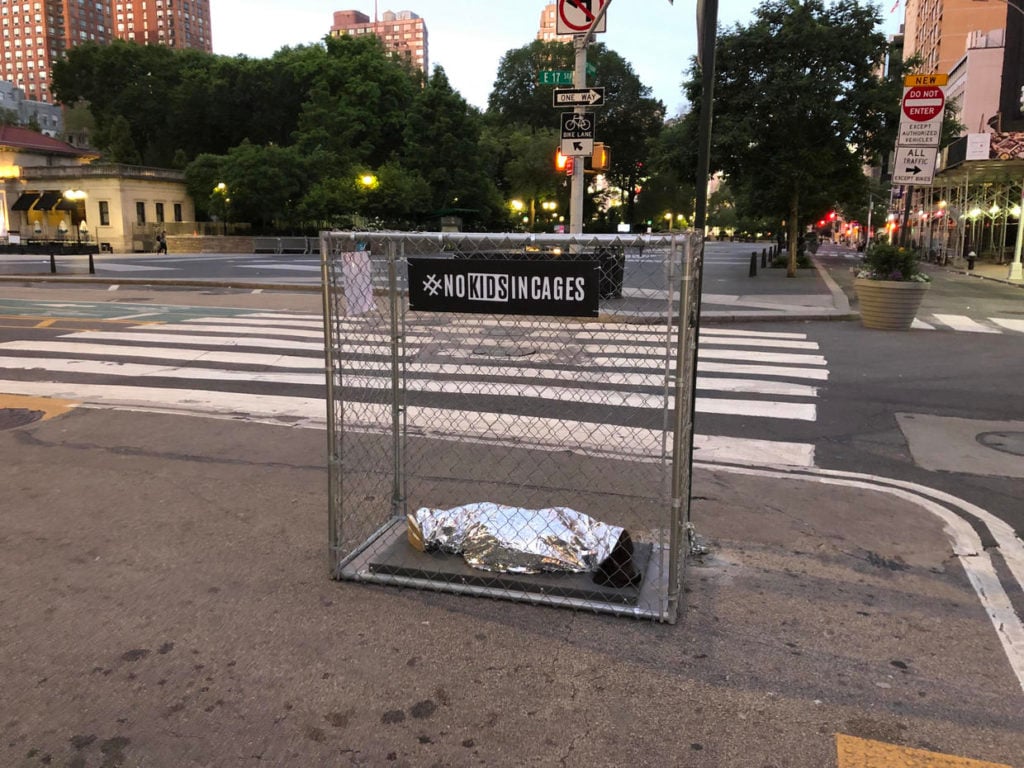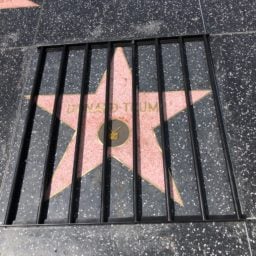On Wednesday morning, a bold guerrilla art installation appeared on the streets of Manhattan, calling attention to the plight of immigrant children currently being forced to live in cages in detention centers on the southern border of the United States. Each of the 24 sculptures depicted a small child, draped in a foil blanket and huddled on the floor of a tiny cage, with disturbing and real audio of crying children who have been separated from their families, recorded by news outlets.
Signs on each sculpture explained the works and provided information about No Kids in Cages, a campaign from the Refugee and Immigrant Center for Education and Legal Services, known as RAICES. The artworks served as a “protest to the more than 3,000 children separated from their parents at the border,” RAICES wrote on Twitter. “This is not history. This is happening now. #NoKidsInCages is about the children. We cannot be a nation that separates families.”
The piece quickly went viral on social media, even as NYPD officers began arriving on the scene to impound the artworks, which were installed in front of major news organizations and media companies, such as CNN, NBC, and Buzzfeed, as well as popular tourist destinations such as the American Museum of Natural History and Union Square. The demonstration was a push to get Congress to pass HR541, the Keep Families Together Bill.
To get their message across, RAICES enlisted ad agency Badger & Winters to come up with the concept—a job the firm did pro bono. The result was a campaign that was part advocacy, part guerrilla advertisement, part art.
“We were all really outraged when [family separation and the detention of children] first happened, but in this 24/7 news cycle it’s hard to hold on to that, because it seems like there’s something outrageous happening every single day,” Madonna Badger, the ad company’s CCO and founder, told artnet News. “We wanted to do something that would stand out, to help save these kids.”
There were several concepts considered for the action, but Badger ultimately felt that the cage sculptures, paired with the recordings of crying immigrant children, was the simplest and most powerful, accurately reflecting the conditions RAICES had witnessed in border detention facilities.
“They don’t let you take out any photographs, and they don’t let you take any videos,” Badger said. “The only thing [news outlets] could sneak out was the cries of the children.”
The design was executed by Brooklyn design firm Square Design Inc. with the assistance of a team of ten street artists. artnet News spoke to the artist who helped fabricate the sculptures and was in charge of the installation. He preferred to remain anonymous.
“We did it very early in the morning so that people would see them when they came out of the subway. If you’re conspicuous enough, people will assume that you’re supposed to be doing whatever you’re doing,” he said. “We knew they wouldn’t last long out on the street, because no business or residence wants to be fined for sidewalk obstruction.”
Sure enough, within hours, most of the artworks had been removed from view. In Midtown, nearly a dozen police were on hand outside the FOX News studios to impound one of the sculptures, according to NBC. A police spokesperson told Gothamist that the NYPD had found eight of the 24 sculptures.
“It’s funny that they’re so efficient about taking something off the street that’s political,” said the artist. “If it was a couch or a baby carriage out on the street, it would take forever.”
There are no plans to recover the sculptures used for this week’s action, but Badger would love to stage the project again, preferably in Washington, DC. “Our goal is to be able to bring this to more and more people’s attention,” she said. “Within a few hours, it was up to like 12 million impressions.”
And while the art alone is unlikely to change the minds of members of the House of Representatives, Badger hopes it may encourage the public to lobby their representatives to pass HR541. “It pierced the consciousness of people again,” she said.









